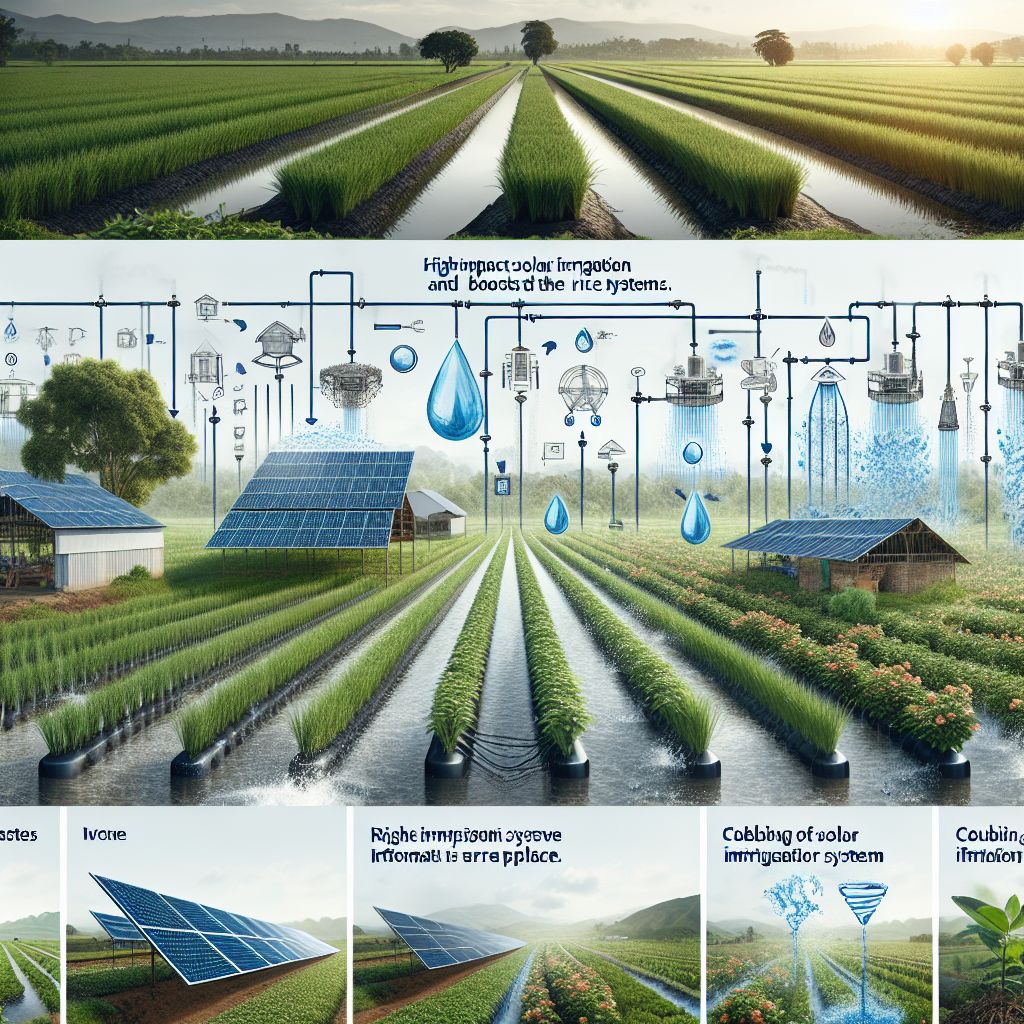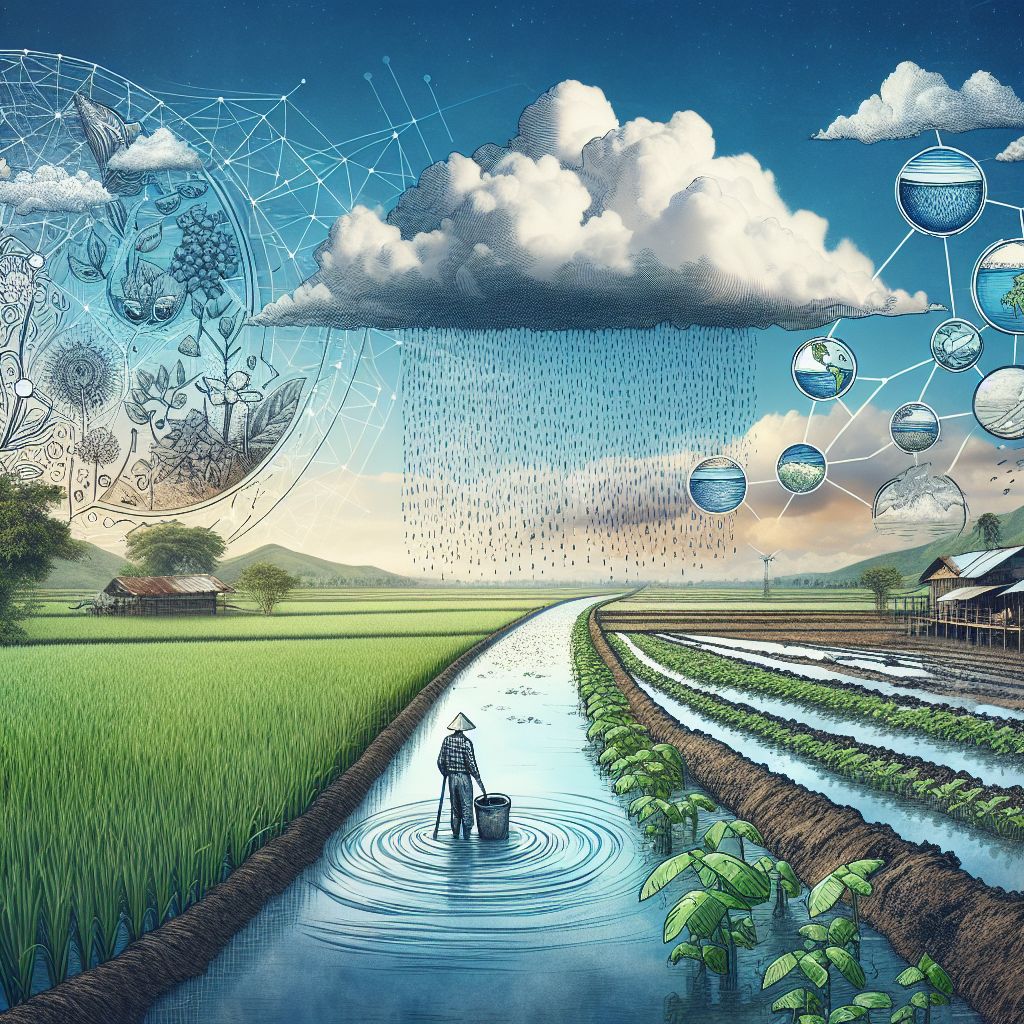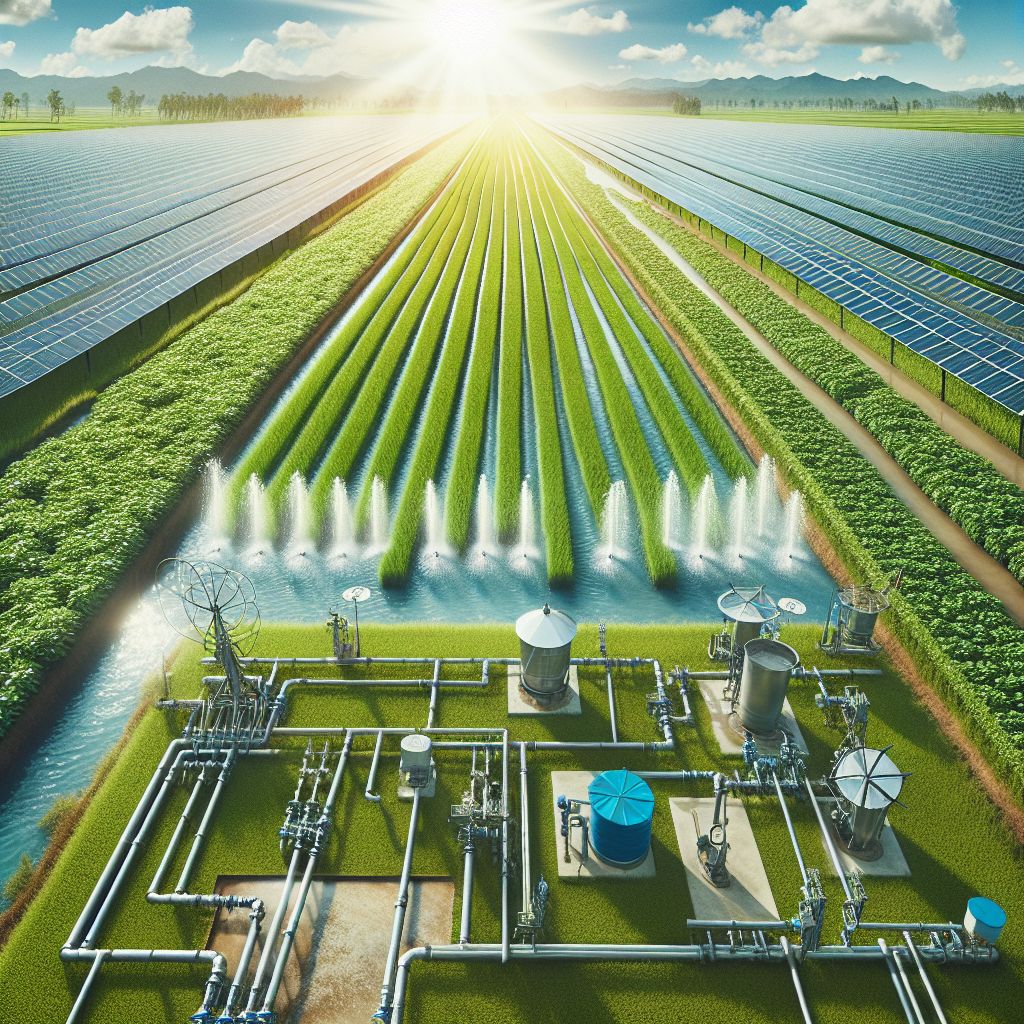
Quick Summary
Discover the importance of efficient solar irrigation in rice farming for sustainability and profitability.
Understand how modern irrigation techniques can save water and increase rice yield.
Learn about the problems and environmental effects of traditional irrigation methods.
Explore the advantages and application of high-impact solar irrigation systems like drip and automated systems.
Think about the combination of solar panels with irrigation systems for energy efficiency and cost reduction.
Watering Rice Fields: Choosing the Right Irrigation
Water is as important as the seeds in rice farming. But it’s not just about any splash of water – it’s about giving your crops the right quantity at the right time. That’s where smart irrigation comes in. It’s like watering your rice fields’ thirst in a way that’s both effective for growth and friendly to the environment.
The Importance of Efficient Irrigation in Rice Farming
Despite the reputation of rice paddies as water guzzlers, it is possible to use water more efficiently with the right techniques. Efficient irrigation is important because it makes sure that every drop of water is used to its maximum potential. This leads to healthier rice plants, higher yields, and a more sustainable environment. It’s not just about using less water, it’s about using water smartly.
Can You Really Get More Rice with Less Water?
You might find it hard to believe, but it’s true. You can get more rice from your farm while using less water. It’s all about being precise. You have to make sure the water goes exactly where your rice needs it and exactly when your rice needs it. This kind of precision stops you from wasting water and helps your rice grow strong. So yes, it’s not only possible, it’s the future of rice farming.

Water Woes: The Problems of Rice Irrigation
Rice irrigation has its fair share of problems. Let’s look at the most important ones. Traditional flooding methods require a lot of water. Weather and water availability are unpredictable. There is an urgent need to save water and reduce environmental impact. These issues make rice irrigation a complex problem to solve.
Wastage of water due to the inefficiency of traditional flood irrigation.
Challenges in managing water resources due to unpredictable weather conditions.
Environmental issues due to the overuse and mismanagement of water.
Challenges in Traditional Rice Irrigation Methods
Traditional flood irrigation might appear simple, but it is full of challenges. Overuse of water not only depletes resources but also leads to issues such as soil erosion and nutrient runoff. These methods can be unreliable, particularly in regions where water is scarce or droughts are frequent.
First and foremost, we have to understand that water is a valuable resource. Therefore, it’s crucial to abandon these old-fashioned habits and adopt strategies that promote sustainable farming.
The Consequences of Wasting Water on the Environment and Economy
Wasting water on rice farms doesn’t just deplete our rivers and streams; it also depletes farmers’ bank accounts. As the price of water continues to rise, so does the need to save it. And let’s not forget the environmental cost – when water is wasted, habitats can be ruined, and biodiversity can be negatively impacted.
Hence, we need to do something to lessen these effects. It begins with knowing and applying more effective irrigation methods that will protect our natural resources and the lives of the people who rely on rice farming.

High-Impact Irrigation Techniques: A Recipe for Efficiency
What does this recipe for efficiency look like? It’s a blend of old-school wisdom and state-of-the-art tech. We’re referring to systems that bring water straight to the roots, minimize evaporation, and reduce runoff. These techniques not only conserve water, but also cut back on energy and labor expenses.
From Flood to Drip: Shifting to Contemporary Approaches
Shifting from flood irrigation to contemporary approaches such as drip irrigation can be a turning point. Drip systems distribute water straight to the base of each plant, which significantly reduces waste. It’s as if you’re giving each rice plant its own individual water bottle instead of tossing buckets of water and hoping for the best.
With its precise delivery, drip irrigation can decrease water usage by as much as 50% compared to conventional methods. This is a significant reduction, benefiting not only the environment, but also your farm’s bottom line.
Here is a table comparing the pros and cons of flood irrigation versus drip irrigation for growing rice:
|
Aspect |
Flood Irrigation |
Drip Irrigation |
|---|---|---|
|
Water Usage |
High water usage can waste up to 50% of water. 1 |
Reduces water usage by up to 70%. 5 |
|
Yield |
Traditional method, yields can be high with proper management. 4 | |
|
Labor |
Requires labor for leveling fields and maintaining flooded conditions. 1 |
Reduced labor requirements compared to flood irrigation. 1 |
|
Fertilizer Efficiency |
High nitrogen and phosphorus use efficiency under flooded conditions. 4 |
Improved fertilizer use efficiency by delivering nutrients directly to roots. 1 |
|
Weed/Pest Control |
Flooding helps control weeds, but can promote pests like rice water weevil. 4 |
May require additional weed/pest management. 1 |
|
Methane Emissions |
Diminishes methane emissions to almost zero. 5 | |
|
Soil Health |
Can lead to soil compaction and erosion. 1 |
Improves soil health by reducing compaction and erosion. 1 |
|
Initial Investment |
Relatively low investment for leveling fields. 3 |
Requires investment in drip system infrastructure. 1 |
|
Climate Resilience |
Vulnerable to drought and floods. 1 |
Provides more precise control over water for climate resilience. 1 |
Automated Systems: The Power of Technology for Precision
Another key player in efficient water management is automation. Automated irrigation systems remove the uncertainty from watering your rice. Soil sensors can accurately determine when your crops need water, and the system can provide the exact amount of water required. This is what we call smart farming – utilizing technology to make precise, informed decisions that are beneficial to your crop, your finances, and the environment.

Boosting Irrigation System Efficiency with Solar Panels
Now, think about this. Picture merging the accuracy of contemporary irrigation methods with the might of the sun. Solar panels can power your irrigation system, reducing energy expenses and increasing your sustainability efforts. It’s a double victory: your rice farm receives the necessary water, and you decrease both your carbon emissions and your electricity bill.
Using Renewable Energy for Irrigation
Adding solar panels to your irrigation system is more than just a green choice; it’s also a financially savvy one. Solar energy can run pumps and sensors, allowing the irrigation process to be completely self-sustaining. This reduces the dependence on electricity from the grid or diesel generators, resulting in substantial cost savings over time.
Should Solar Panels be Incorporated into Every Irrigation System?
Should every irrigation system include solar panels? This depends on several factors such as the size of the farm, the local climate, and the initial investment you are willing to make. However, for most farms, the answer is a definitive yes. This is especially true when you take into account the long-term benefits and savings.
Keep in mind, the upfront cost may be more, but solar panels last a long time. They’re a long-term investment that not only benefits your wallet, but also the environment.
Savings and Eco-Friendly Advantages of Solar-Powered Irrigation
When it comes to money, let’s talk specifics. While the initial investment in solar panels can be substantial, they usually pay for themselves in just a few years. After that, the energy they produce is practically free. Additionally, you’re doing your part to cut down on greenhouse gas emissions, which is invaluable for the planet.
Also, remember that there are government incentives and grants that can help reduce the initial cost. It would be beneficial to look into what is offered in your area.

How to Set Up an Effective Solar Irrigation System
Are you prepared to roll up your sleeves? Setting up an effective solar irrigation system is a methodical process. It begins with planning – understanding the specific requirements of your farm and selecting the appropriate system. After that, it’s all about installation, observation, and management.
Why Planning is Important in Setting Up an Solar Irrigation System
Planning is the first step in setting up an effective solar irrigation system. You need to take into account the layout of your farm, the type of soil, the climate, and the actual water requirements of your rice. If you get this step right, you’re on the right track.
Plan your farm, do the math, and don’t be afraid to ask for help from professionals or other farmers who have already switched to efficient irrigation. Information is key, and in this situation, it could lead to a more successful and profitable farm.
Keeping an Eye on Water Distribution for the Best Outcomes
Even when your system is fully operational, there’s still work to be done. Ensuring the best outcomes involves closely monitoring and managing water distribution. This includes regular equipment checks, staying updated on the weather, and being prepared to modify your watering schedule when necessary.
While automated systems can lessen the workload, nothing beats the intuition and hands-on approach of a farmer. Be proactive, stay informed, and always be prepared to make necessary adjustments for maximum yield.
Here is a table outlining the key steps to consider when setting up a solar irrigation system for growing rice:
|
Step |
Description |
|---|---|
|
1. Site Assessment |
– Evaluate sunlight exposure and intensity at the location throughout the year. 2 |
|
2. System Sizing |
– Calculate water requirements based on irrigation needs for rice cultivation. 2 |
|
3. Solar Panel Installation |
– Mount solar panels securely on structures or ground mounts. 2 |
|
4. Pump and Controller Setup |
– Select appropriate motor size for desired flow rate and water volume. 3 |
|
5. Distribution System |
– Install pipes, valves, and irrigation equipment (e.g., drip lines, sprinklers) for water distribution. 2 |
|
6. Water Management |
– Consider implementing water-saving techniques like Alternate Wetting and Drying (AWD) for rice cultivation. 4 |
|
7. Maintenance |
– Clean solar panels regularly for optimal energy production. 2 |
Final Thoughts:
Effective solar irrigation is the lifeblood of sustainable rice farming. It’s all about achieving more with less, and doing it in a smarter way. By adopting contemporary irrigation methods, incorporating solar energy, and managing your water supply with accuracy, you’re not just cultivating rice – you’re cultivating a legacy.
It’s a leap of faith, but one that ensures a future where both farmers and the environment can prosper. So, take that leap – for your farm, for your loved ones, and for the planet.
Wrapping Up the Advantages of Effective Irrigation in Rice Cultivation
Effective irrigation is the foundation of sustainable rice cultivation. By embracing contemporary methods such as drip, solar, and automated systems, cultivators can greatly decrease water usage while increasing crop production. The advantages go beyond the field, with environmental and economic benefits such as preservation of valuable water resources, decrease in energy use, and cost reductions on water and energy expenses. This progressive mindset prepares cultivators to face the challenges of a shifting climate and an increasing worldwide population.
Steering the Shift: Inspiring Farmers to Embrace Modern Irrigation Systems
Change may be challenging, but it is crucial for advancement. To inspire farmers to embrace modern irrigation systems, we must emphasize the long-term advantages and offer assistance throughout the shift. This involves providing education, sharing triumphs, and helping with access to financial aid or subsidies for gear. By building a community of practice, we can make certain that farmers not only adopt new systems, but also flourish using them.
Commonly Asked Questions
These are some of the usual questions that farmers might ask when they are thinking about changing to a more efficient irrigation system for their rice farms.
Which irrigation system for rice farms is the most efficient in terms of water usage?
Drip irrigation is the most water-efficient irrigation system for rice farms. This method supplies water directly to the roots of the plants, which reduces evaporation and runoff. Drip irrigation can save up to 50% of the water used in traditional flood irrigation, making it not only efficient but also good for the environment.
How does solar-powered automatic irrigation save water?
Solar-powered automatic irrigation systems save water by using sensors to accurately measure the water needs of rice plants. These systems give the correct amount of water at the correct time, removing the guesswork and reducing the amount of water wasted. The use of solar power adds to the efficiency of the system by using renewable energy to power the pumps and sensors, making the system both sustainable and cost-effective.
Are solar panels compatible with all irrigation systems?
Although solar panels are adaptable, they are most efficient when paired with systems that can function on the fluctuating power they supply. Drip and sprinkler irrigation systems are ideal for solar power because they can be set to work at various times of the day, corresponding with the hours of maximum sunlight.
For instance, a farmer with solar panels powering a drip irrigation system can schedule watering for midday when sunlight is most plentiful, maximizing the use of solar power and ensuring water is delivered efficiently.
This alignment of solar power availability with irrigation needs provides an energy-efficient and cost-saving solution for rice farming.
How much will it cost me to install a solar-powered irrigation system?
There is a range of costs associated with installing a solar-powered irrigation system. You can expect to pay anywhere from $1,000 to $10,000, depending on the size of the system and the specific needs of your farm. Although the upfront cost may seem high, solar systems often pay for themselves within a few years thanks to savings on energy bills. Plus, many regions offer subsidies or tax incentives to help offset these initial costs.
How does the selection of a solar irrigation system influence the total crop yield?
Selecting a solar irrigation system can positively influence the total crop yield. These systems encourage healthy plant growth and can boost yield by providing consistent and accurate water delivery. Additionally, the dependability of solar power ensures that irrigation schedules are upheld even during power outages, guaranteeing that crops are watered without interruption.
Additionally, using renewable energy sources helps to lower the carbon emissions from farming activities, which in turn supports a healthier environment that is good for crop development. If planned and managed well, a solar-powered irrigation system can be a worthwhile investment for rice farmers who want to boost their harvests in an eco-friendly manner.
In the end, the long-term success of farmers can be assured by rice farm irrigation techniques that focus on efficiency and sustainability. Rice farmers can maximize yields, reduce costs, and contribute to environmental conservation by implementing modern irrigation methods, integrating renewable energy sources, and managing water resources effectively. As the agricultural sector continues to evolve, embracing these advanced systems will be crucial for farmers to stay competitive and sustain their livelihoods in a changing world.







Leave a Reply